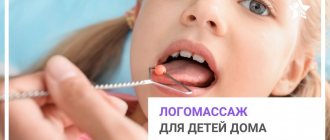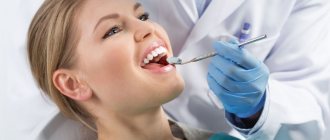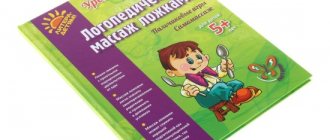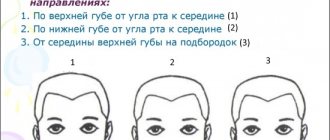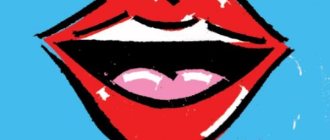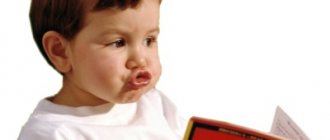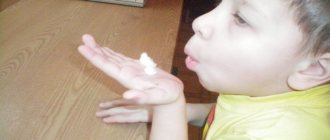Indications for testing
Severe speech disorders are often accompanied by problems with the nervous system. With dysarthria, the parts of the brain responsible for the innervation of muscles are affected. With this pathology, children cannot switch articulatory postures or feel subtle movements of the tongue and lips.
The leading defect is a violation of the phonemic aspect. Child says:
- indistinct;
- distorting sounds;
- unimpressive.
Vocabulary and grammar do not always suffer. When pronouncing a sound, the tongue deviates to the side or is limited in its movements. The tip protrudes between the teeth, that is, interdental pronunciation appears.
In case of severe disorders, asymmetry of the lips and a tense, balled tongue are noticeable (or it may be sluggish and relaxed). The erased form of dysarthria is difficult to determine, since only the pronunciation of 1-2 groups of sounds suffers.
Without probe massage it will not be possible to correct any form of dysarthria. Without it, producing sounds will take several years, and in most cases the result will be zero.
The use of massage probes to correct dyslalia is controversial. If there is a violation, only the pronunciation side of speech suffers. Massage strengthens the muscles of the articulatory apparatus, prepares them, and speeds up sound production. Some speech therapists are of the opinion that this is unnecessary.
With dyslalia, the hyoid ligament may be shortened. It limits the mobility of the tongue, a number of sounds are disrupted (sonoras, hissing). It is advisable to surgically trim it, but not all parents agree to this. Therefore, the frenulum is stretched with a probe; with a mild degree of the defect, its elasticity can be significantly improved.
Speech therapy probe massage is prescribed for alalia. With this problem, certain areas of the cerebral cortex are affected. The child has normal physical hearing, but at 4 years old he does not speak. In the motor form, the baby understands spoken speech, but uses gestures himself.
Massage stimulates the flow of signals into the brain, which promotes the development of the affected areas. After the course of treatment, onomatopoeia appears.
The cause of rhinolalia is defects in the structure of the speech apparatus (cleft lip, gums, palate). After the operation, scars remain that interfere with the mobility of organs. Probes are used to knead the seams and stimulate muscle function.
Dyakova recommends probe massage to correct stuttering. The defect is based on seizures of various origins. Due to muscle tension, it is difficult for a person to say something. Massage is used for relaxation.
Article:
Experience in working with children with speech disorders (impaired sound pronunciation) and weak tone of the tongue muscles has shown that the combination of special articulatory gymnastics and tongue massage makes it possible to strengthen the muscles, develop full-fledged movements necessary for the correct pronunciation of speech sounds and, most importantly, reduce the production time sounds.
Massage is performed in clinics and speech centers using special probes. But not all children agree to such a massage, although its effectiveness is undeniable. Speech therapy massage can be performed at home using a children's toothbrush, having previously grabbed the tongue with gauze napkins. The duration of the massage is 5 – 7 minutes. Course 10 – 14 days. Then take a break and repeat the course as necessary.
download abstract
Types of movements during massage: longitudinal transverse circular stroking; circular spiral rubbing; longitudinal, circular pressure, kneading; shock intermittent or continuous vibration;
If your child’s tongue is weak, sluggish and many movements are not available to him due to muscle weakness, then the movements will be from the periphery (edge of the tongue) to the center of the tongue - to tone the muscles.
In addition to a toothbrush, you can simply use a cleanly washed finger (or put a baby pacifier scalded with boiling water on your finger). And start patting, stroking and kneading the child’s tongue.
If your child does not like this procedure, try first dipping your finger in something tasty that your baby loves: jam, honey, sour cream.
During the massage, do not forget to comment on your actions: let’s stroke the back of the tongue, like a kitten, let it become soft and obedient, and now its sides, and here is the tip of the tongue. This must be done so that the child can better imagine and feel his organs of articulation.
However, remember that there are contraindications:
These are any wounds or infections of the oral cavity, herpes, cracks, as well as discomfort in the child during a massage.
Enjoy your massage!!!
Equipment: personal toothbrush, tongue napkin
Make the child sit down and make a “spatula” (the adult holds the tip of the child’s tongue with a napkin).
1. “The tongue woke up and stretched”
Use the back of the brush to move from the middle of the tongue to the tip
2. "Sunny"
Move the brush in directions from the periphery to the center (do not touch the root of the tongue!)
3. “Herringbone”
First, move the brush along the length of the tongue, then along the lateral edges of the tongue from the periphery to
Move the brush in horizontal lines from left to right.
5. “Smoke is coming from the chimney”
Zigzag movements of the brush along the surface of the tongue from root to tip and from tip to root.
6. "The wind blows to the left"
Move the brush in horizontal lines from right to left
7. “It’s raining”
Tap your tongue with the bristles of the brush from center to tip, from left to right and from right to left.
8. “Leaves are Falling from the Trees”
Tap the tongue with the back of the brush from center to tip, from left to right and from right to left.
9. "Big Puddle"
Use the back of the brush to move clockwise from the edge of the tongue to the center.
General recommendations for conducting
The duration of the course is calculated individually. On average, 10 procedures performed every other day are sufficient. Between cycles there is a break of a month. Some speech therapists prefer to include massage before each session.
The duration of the procedure depends on:
- from age;
- degree of defect;
- personal characteristics.
The minimum time is 5 minutes, the maximum is 25. The impact should not cause pain, slight discomfort is allowed. Children may be afraid of probes because they resemble medical instruments. You can let them touch them, play with them, or have a session with toys.
In case of negativism, hysterics, aggression, the first sessions are kept as short as possible. Start by stroking the lips, cheeks, and tip of the tongue. With a pronounced gag reflex, the effect begins with a light one, gradually moving deeper into the mouth.
Massage sessions are carried out in a well-ventilated area. It should be warm, bright, cozy.
TONGUE MASSAGE USING A TOOTHBRUSH. EXERCISES methodological development on speech therapy on the topic
TONGUE MASSAGE USING A TOOTHBRUSH
(according to Pozdnyakova L.A., revised and supplemented by Dubinina T.A.)
Equipment: personal toothbrush, tongue napkin
Sit the child down, make a “spatula” (the speech therapist holds the tip of the child’s tongue with a napkin)
- “The tongue woke up and stretched”
Use the back of the brush to move from the middle of the tongue to the tip
- "Sun"
Move the brush in directions from the center to the periphery (do not touch the root of the tongue!)
- "Herringbone"
First, move the brush along the length of the tongue, then along the lateral edges of the tongue from the center to the periphery
- "The wind blows to the right"
Move the brush in horizontal lines from left to right
- "Smoke is coming from the chimney"
Zigzag movements of the brush along the surface of the tongue from root to tip
- "The wind blows to the left"
Move the brush in horizontal lines from right to left
7. “Rain is dripping” Tap the tongue with the bristles of a brush
| ………. ………. ………. ………. |
8. “Leaves are falling from the trees” Tap the back of your tongue
side of the brush
| — — — — — — — — — — — — — — — — — — — — — — — — |
- "Big Puddle"
Move the back of the brush clockwise from the middle
tongue to the edges
"Autumn Tale"
Tongue woke up and stretched (exercise No. 1).
Tongue looked out the window - the sun was shining! (exercise no. 2)
A Christmas tree with fluffy branches grew under the window (exercise No. 3).
Suddenly a strong wind blew, and the Christmas tree tilted to the right (exercise No. 4).
The tongue sees smoke coming from the chimney (exercise No. 5).
Suddenly the breeze blew to the left, and the Christmas tree tilted to the left (exercise No. 6).
The sun hid behind a cloud, and it began to rain heavily (exercise No. 7).
Autumn leaves fall to the ground (exercise No. 8).
It is raining, and a large puddle has spilled under the window (exercise No. 9).
"Winter's Tale"
Tongue woke up and was basking in bed (exercise No. 1).
Tongue looked out the window - it was snowing (exercise No. 7).
Tongue went out for a walk, and the wind was blowing outside (exercise No. 4).
The tongue sees smoke coming from the chimney (exercise No. 5).
Suddenly the breeze blew to the left, and the smoke tilted to the left (exercise No. 6).
The puddle under the window froze, and Tongue began to ride on it (exercise No. 9).
There was also a big slide in the yard (make a “slide” with your tongue).
Tongue started sledding down the hill! (move the back of the brush along the “slide” from top to bottom).
Covered in snow Tongue!
He began to knock the snow off his hat with his mittens (exercise No. 8).
Tongue cleaned his overalls and went home (exercise No. 1).
TONGUE MASSAGE USING A TOOTHBRUSH
(according to Pozdnyakova L.A., revised and supplemented by Dubinina T.A.)
Equipment: personal toothbrush, tongue napkin
Sit the child down, make a “spatula” (the speech therapist holds the tip of the child’s tongue with a napkin)
- “The tongue woke up and stretched”
Use the back of the brush to move from the middle of the tongue to the tip
- "Sun"
Move the brush in directions from the center to the periphery (do not touch the root of the tongue!)
- "Herringbone"
First, move the brush along the length of the tongue, then along the lateral edges of the tongue from the center to the periphery
- "The wind blows to the right"
Move the brush in horizontal lines from left to right
- "Smoke is coming from the chimney"
Zigzag movements of the brush along the surface of the tongue from root to tip
- "The wind blows to the left"
Move the brush in horizontal lines from right to left
7. “Rain is dripping” Tap the tongue with the bristles of a brush
8. “Leaves are falling from the trees” Tap the back of your tongue
side of the brush
- "Big Puddle"
Move the back of the brush clockwise from the middle
tongue to the edges
Probe kit
Speech therapy probes for producing sounds (authored by Rau) are not suitable for massage. A special set was developed by E. V. Novikova. It includes 8 main probes plus 4 additional ones. A patent for the development was received in 2000.
Probes are used to work with articulatory organs and the forearm. Stimulating the muscles of the dominant hand improves motor skills and promotes handwriting development.
The first tool is a fork , which looks like two blunt needles slightly apart to the side. A slight tingling sensation has an activating effect.
The second instrument is the eight . At the end there is a round loop that “grinds” the muscles.
The third, fourth, fifth tools are “sleighs” of different sizes. The shape of the probes resembles the rounded runners of a sled, hence the name. You can work with either side of the tool.
The sixth tool is a hatchet , which looks like two tightly pressed loops. Used for pressing on the surface of organs, sliding. Normalizes tone and increases muscle mobility.
The seventh is a cross, the loops are rounded and intersecting . It is used to stimulate the muscles of the tongue and develop its elevation.
The eighth tool is a pusher , a small loop raised at a right angle to the probe handle. Allows you to stimulate mobility and elasticity of muscles. When you press on the tongue, it creates tension; after the pressure is removed, the organ relaxes.
The ninth tool (additional) - tweezers , looks like two large rounded loops located parallel to each other. It is convenient to take the tongue with a probe and gently move it.
The tenth tool is a pull-up tool that looks like a low, wide frame. Used to stretch the frenulum.
The eleventh tool is a swan , a small loop, bent at the base, after which there is a small vertical section of the probe, which is bent at a right angle to the probe handle. Massages the palate, eliminates salivation.
The twelfth is sliding, looks like an elongated triangle with round corners. Used for sliding movements.
Some authors made their own adjustments to the set of massage probes. Vorobyova together with Krupenchuk created the author's set. It consists of 9 instruments. The creation of probes with different coils with small edges can be considered an innovation. This tingling sensation can effectively stimulate the nervous system.
Speech therapy tongue massage
The tongue is the main organ of speech. Therefore, speech therapy massage of the tongue for dysarthria is a necessary element of treatment. Helps fight weakness, limited muscle mobility, paresis and paralysis. Specialists use several techniques in their work. Let's take a closer look at them.
Massage with a toothbrush
A toothbrush, due to its bristles, perfectly warms up the tongue. It can be used both in classes with a speech therapist and for independent speech therapy massage at home. The approximate steps are as follows:
- Place a paper napkin or handkerchief under your tongue to prevent saliva from running off and irritating your skin. When the napkin gets wet, you need to change it;
- the child should relax his tongue as much as he can;
- first perform circular kneading movements along the back of the tongue, the pressure should not be strong;
- stroking over the entire area of the tongue, intermittent movements, as when brushing teeth;
- the baby tenses his tongue, lifting it upward, you massage the lower part of the tongue and the pit under it.
When massaging, be careful not to trigger a gag reflex in the child.
Tongue massage with fingers
Finger speech therapy massage of the tongue for dysarthria allows you to work all muscle groups, including deep ones. Sessions help relieve hypertonicity of facial and articulatory muscles. To carry out the procedure, you need a clean handkerchief, fabric napkins, and special finger pads.
The stages are:
- Relaxation of the tongue muscles;
- Grab your tongue with two fingers, twist it clockwise and counterclockwise, tap on the back;
- Move towards yourself, while grabbing the tip with three fingers: one from above, two from below;
- Now let's deal with the middle part of the tongue. Also grab your tongue and pull it towards you, holding this position for a couple of seconds;
- Grab your tongue and pull it towards you a little. In this position, use the fingers of your other hand to make squeezing movements over the entire surface of the tongue. They squeezed - they let go, they squeezed - they let go;
- Turns around an axis, while the tongue needs to be placed on one edge, hold it for a couple of seconds, then on the other edge;
- It is also necessary to work with the lips - their role in articulation is significant. Tap them with your fingertips, stretch them up and down, and roll them into a tube.
Speech therapy massage for various forms of dysarthria should be performed once or twice a day, for 15 minutes, for a couple of weeks. The speech therapist will tell you the exact duration and quantity: it all depends on the diagnosis and the degree of impairment. Also consider age: small children cannot sit for long, so choose a few exercises one day and do only them. And the next day, do others.
Probe massage
One of the modern correction methods is probe massage for dysarthria. This is one of the new treatment methods that is gradually gaining popularity. It is carried out using special probes developed by E. V. Novikova, Doctor of Pedagogical Sciences.
The standard set consists of 9 tools, each of which is designed for specific purposes. For example, sleds, shaped like sled runners with rounded ends, are designed to stimulate muscles. The “hatchet” in the form of two flattened loops can be used with both increased (light pressure) and decreased tone (strong pressure) of the muscles.
There are variations by other authors, for example, probes with a su-jok effect for additional stimulation of nerve endings and muscles.
After the sessions, children’s speech breathing normalizes, their voice becomes expressive and strong, defects in sound pronunciation are eliminated, and the condition of the central nervous system improves.
Articulatory massage with probes for dysarthria should not be performed on children under six months; at this age there is no such need.
The sequence of a relaxing massage is determined by a speech therapist/speech pathologist, based on the specific situation, the severity of the disease and the age of the patient. The standard tactics are as follows:
- The tool in the form of a small ball needs to be moved over the entire surface of the tongue;
- Piercing the tongue with a pitchfork-shaped probe. Muscle contraction occurs. Then the doctor makes oscillatory and rotational movements with the instrument at various points for five seconds;
- Using a figure eight, press on the organ at several points;
- “Sleds” come in three sizes. They also make pressing movements;
- "Hatchets" are used to slide with little pressure;
- Use a “crosspiece” or “pusher” to press on the tongue, and then remove the probe. The muscles of the tongue contract.
Probe massage for dysarthria is carried out for a long time: usually in courses of 2–3 weeks. Each movement must be repeated 20–30 times. A repeat course is indicated after a month and a half.
Advantages and disadvantages of the technique
Probe massage allows you to speed up the production of sounds, facilitate the assimilation of articulatory gymnastics, and improve muscle function. Without it, correction of dysarthria will take 5-10 years.
It does not require special conditions, since it can be done by any speech therapist with the appropriate qualifications. In many correctional institutions, it is carried out by specialists as needed.
Massage helps relieve tone, hypersalivation, and improve fine motor skills.
It also has disadvantages. The significance and value of massage is overestimated - it is an auxiliary tool, not a panacea. Low-qualified speech therapists provide probe massage as a cure for all problems. In fact, the impact only provides the basis for producing sounds, which does not cancel the remaining stages of the work.
If used incorrectly, tools cause negativity in the child, since if they are not understood, they can cause serious harm. Some specialists act rudely and incorrectly, which leads to pain and the child’s refusal to study.
Contraindications
Massage courses are prescribed by a neurologist after a complete examination. It should not be used for epilepsy of various forms, as it can provoke seizures.
Temporary withdrawal is given for any infectious or somatic diseases. Probe massage should not be performed for stomatitis, caries, gingivitis, or skin diseases. Herpes and oral infections also serve as a medical outlet for procedures.
It should not be done if there is strong pulsation of the arteries, high blood pressure, or poor physical well-being.
If you have nausea, vomiting, or fatigue, you cannot conduct a session; it is better to reschedule it for another time. A speech therapist examines each child before performing a massage.
Tongue massage
It is important for weakness of the muscles of the main speech organ, insufficient mobility of the lingual muscles, paresis and paralysis. Speech therapists and speech pathologists use several techniques for kneading an unruly tongue. Let's talk about each technique in more detail.
Massage with a toothbrush
To knead the muscles of the tongue and cheeks at home and in classes with a professional, you can use a regular toothbrush. The technique of performing the treatment procedure consists of the following stages:
- Place a paper napkin under your child's tongue. It is needed to absorb excess saliva. If moisture accumulates in your mouth too quickly, change your napkin more often.
- Ask your baby to relax his tongue.
- Make circular kneading movements along the body of the speech organ.
- Then intermittent strokes along the inside of the cheeks, over the entire area of the tongue. It's like you're cleaning something off of him. Be sure to use this movement option for bulbar dysarthria.
- Ask the child to tense his tongue and lift it up slightly.
- Massage the hollow under the jaw. Make movements smoothly, without increased pressure.
Important! For massage with a brush, buy a soft version of tools with smooth and even bristles, so as not to damage the oral mucosa and not to scare the child.
Tongue massage with fingers
Effectively helps relieve hypertonicity of articulatory and facial muscles. It is carried out using a handkerchief, cloth napkin, massage finger pads. The sequence of actions for an adult is as follows:
- Help your child relax his tongue muscles. Take the organ with two fingers, twist it, and lightly tap its surface.
- Pull the tongue by the tip, pressing with two fingers from below, one from above.
- Grasp the middle part. Lift and pull forward. Hold the position for 1-2 seconds.
- Hold your tongue near your lips with one hand. With the fingers of your other hand, squeeze its body pointwise to the root. Repeat forward movements in the opposite direction.
- Turn the tongue with your fingers and place it on the edge. Then to the other side.
- Don't forget to tone your lips. Tap them with your fingertips, roll them into a tube, and stretch them toward your nose.
Perform logomassage with your fingers 1-2 times a day for a week or two. The duration of the lesson depends on the age and temperament of the child.
For preschoolers, it is enough to stretch the lingual muscles for 10-15 minutes a day. Choose 2-3 exercises. Repeat them 30 times during each lesson. The next day, change the set of exercises.
Probe massage
Tongue massage for dysarthria using special instruments—probes—developed by Doctor of Pedagogical Sciences, Elena Viktorovna Novikova. A specialist or parent will need a set of tools - 8 copies. The probes have different shapes: hatchets, balls, forks, snail, fungus.
Instrumental speech therapy massage for dysarthria is carried out in courses. For severe defects, 2-3 weeks daily, then rest for 1.5 months. Then repeat the course.
The method of treating speech defects using probes involves the following types of tongue warming:
- Move the ball tool along the body of the tongue 8-10 times.
- Using a plastic probe, move it pointwise from root to tip 8-10 times.
- Stroke the transverse lingual muscles with a ball tool 6-8 times.
- Take a needle-shaped probe. Tingle the perimeter of your tongue for 10 seconds.
- Find dimples in the sublingual area. Use a ball probe and make counterclockwise turns in the recesses. The maximum time of pressure on the point is 10 seconds.
- Press and comb the tongue with a ribbed probe and a spatula on all sides.
During the procedure, it is better for the child to take a reclining position and place a small pillow under the neck. If a preschooler complains of pain, stop the process or relieve pressure on the speech organ.
On a note! To understand the technique and principle of performing probe logomassage, we recommend reading the book by E.V. Novikova “Probe massage” from parts 1 to 4. The manual is illustrated and is ideal for self-teaching parents using pictures. Or a textbook for speech therapists by O. G. Prikhodko “Speech therapy massage.”
Tool processing
Each set of tools is used once. Afterwards, it is soaked in a disinfectant solution, without removing it from it, and treated with cotton swabs for 30 seconds.
Then the instruments are washed under running water using such products as “Progress”, “Biolot”, “Astra”. Do this for 10 minutes.
The probes are washed in distilled water for 30 seconds. Finally, it is dried in a dry oven.
This is a standard method for sterilizing medical instruments. You cannot neglect it, as this is a violation of the law. Children may have various diseases; in the event of mass infection, there will be serious checks and investigations.
Carrying out at home
Massage has a serious impact on the body. The person who does it must have an appropriate medical education and constantly improve his qualifications. Speech therapists can only do speech therapy massage, both probe and manual.
You should not try to do it yourself. Before the start of the course, the specialist examines the child, examines the articulation organs, determines the tone, and compiles a selection of exercises. A full set of probes is not always needed; often 4-5 are enough.
It is easier for children to tolerate the procedure in another room. Psychologically, it is easier for them to endure discomfort for a while.
The degree of impact of the instruments is chosen by a specialist. Basic techniques:
- pressure;
- slip;
- compression;
- trituration.
The choice of technique is made by a speech therapist. It will be difficult for a parent without special knowledge to choose one. Probe massage can cause harm - tearing the frenulum, causing hypertonicity, strengthening the gag reflex, etc.
